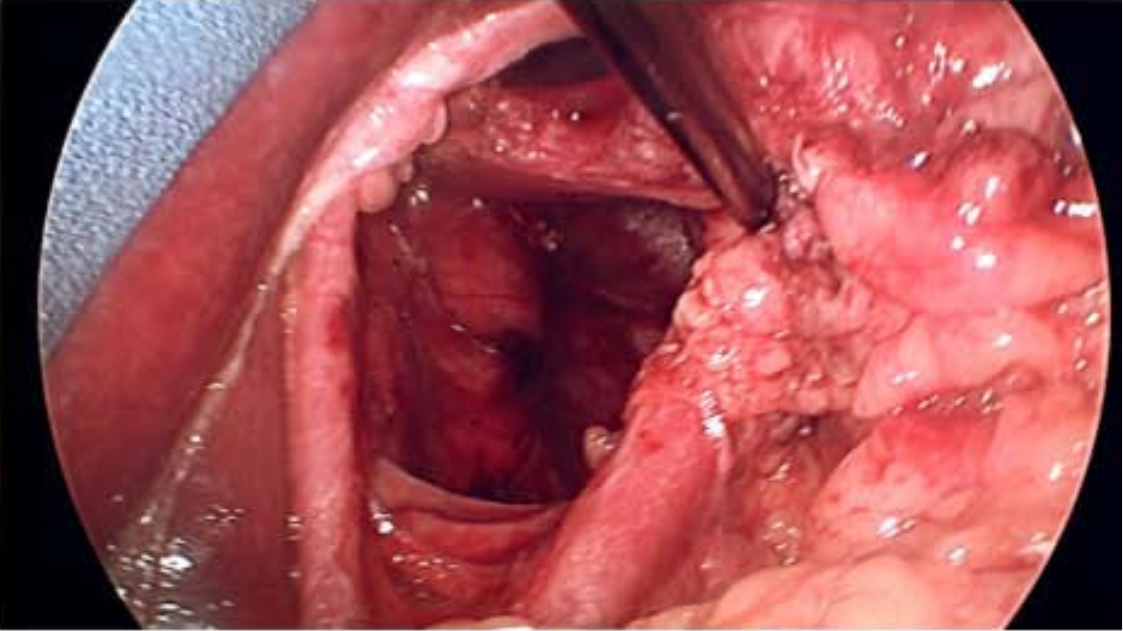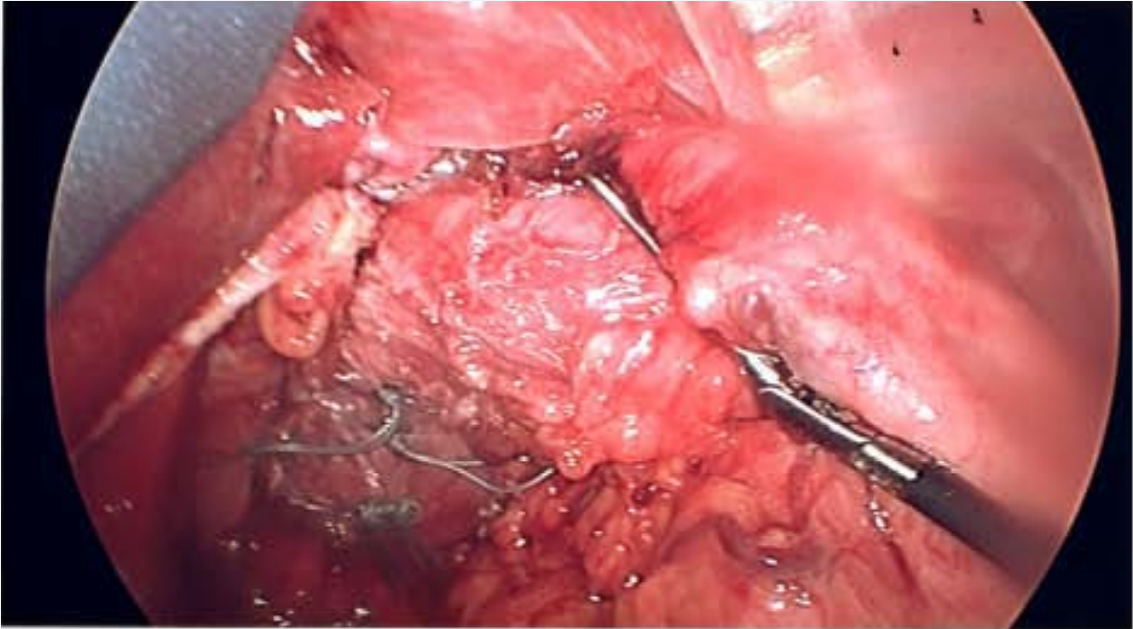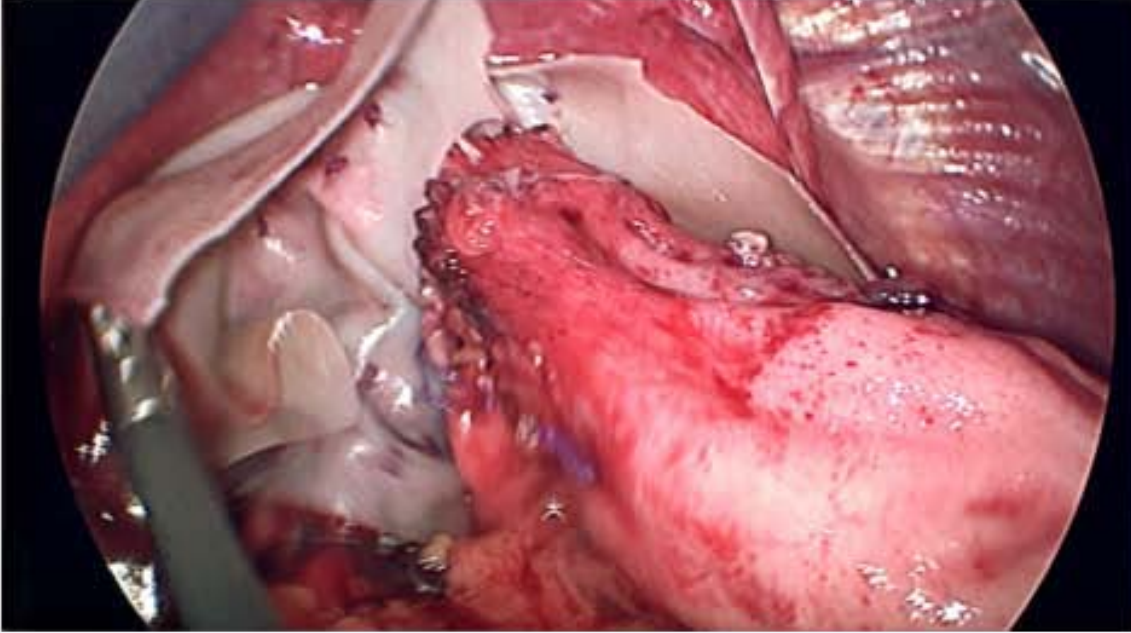Extracellular Matrix Scaffold in Diaphragmatic Crura Reinforcement during Laparoscopic Repair of Large Hiatal Hernia
- 1. Division of Transplantation, University of Cincinnati, Ohio
ABSTRACT
Large hiatal hernias represent a challenge for surgeons. Various biologic grafts were utilized for crural reinforcement during laparoscopic repair. Extracellular matrix scaffold was recently popularized in the treatment of difficult wounds. We present a case of successful reinforcement of the diaphragmatic crura during laparoscopic repair of large hiatal hernia with extracellular matrix scaffold.
KEYWORDS
• Laparoscopic hiatal hernia repair
• Reinforcement of crural closure
• Biologic graft
• Extracellular matrix scaffold
CITATION
Reznichenko A (2016) Extracellular Matrix Scaffold in Diaphragmatic Crura Reinforcement during Laparoscopic Repair of Large Hiatal Hernia. J Surg Transplant Sci 4(1): 1018.
ABBREVIATIONS
CT: Computer Tomography; UGI: Upper Gastrointestinal Series; SIS: Small Intestinal Submucosa
INTRODUCTION
Minimally invasive approach in the repair of hiatal hernias became a standard of care. There is no consensus regarding the reinforcement of the diaphragmatic crura, or the type of the graft used. Biologic grafts in hiatal hernia repairs had proved to be safe. Several different biologic products were utilized for crural reinforcement, with similar outcomes. MatriStem products are porcine-derived extracellular matrices that contain the epithelial basement membrane from porcine urinary bladder matrix and facilitate a constructive tissue remodeling response by the patient’s body. Extracellular matrix scaffold (Acell Matristem®, Acell Inc.) was successfully utilized in the treatment of difficult non healing radiated wounds and complex pilonidal wounds. We present a case of successful reinforcement of the diaphragmatic crura during laparoscopic repair of large hiatal hernia with extracellular matrix scaffold.
CASE PRESENTATION
A fifty three years old female without prior surgeries was presented to doctor’s office with long term history of postprandial epigastric pain, chest pain, nausea and severe dysphagia to solids. Past medical history included scoliosis. She did not have heartburn. Complete blood count and comprehensive metabolic panel were normal. Electrocardiogram was normal. A computer tomography (CT) of the chest and abdomen showed large type IV hiatal hernia with stomach and colon herniated into the chest (Figure 1).
Figure 1: CT axial view. Stomach (red arrow) and colon (yellow arrow) in the chest.
Upper GI endoscopy was negative for esophagi it is, Barrett’s esophagus and esophageal stricture. Elective laparoscopic repair of hiatal hernia was performed with diaphragmatic crura reinforcement using extracellular matrix scaffold.
Surgical technique
Under general endo tracheal inhalational anesthesia and muscle relaxation, patient was placed in modified lithotomy position. Five laparoscopic ports were used along with the five millimeter (mm) 30-degree laparoscope. The position of the ports were as follows: umbilical (5 mm) as an optical port, right upper quadrant (10 mm) for retraction of the left lobe of the liver, three working ports (5 mm each) in the epigastric area, in the left upper quadrant and in the left mesogastrium. The left lobe of the liver was reflected cephalad. Harmonic shears were used for the dissection and controlling the vessels. The diaphragmatic crura were opened from left to right. The short gastric vessels and the posterior gastric vessels to the base of the left crus were divided. The hernia sac was dissected initially from the hiatus, followed by complete circumferential dissection from the mediastinal contents. Esophagus was dissected in the mediastinum as high as possible. Both vagus nerves were identified and preserved. Intra abdominal esophageal length of 3 centimeters (cm) was accomplished with extensive mediastinal dissection; there was no indication to perform vagotomy or Collis gastroplasty for the lengthening of the esophagus. Approximately 60% of the stomach was released from the chest, and this finding correlated with preoperative CT (Figure 1).The size of the hernia was measured as a distance between right and left crus, and anterior to posterior distance between hiatal apex and posterior decussation of the right and left crus (Figure 2).
Figure 2: Large hiatal defect, Esophagus reflected to the left.
This patient had a hernia defect of 9 x 6 cm. Posterior crural closure was performed with interrupted Ethibond Endoknot sutures (Figure 3).
Figure 3: Cruroplasty.
We were able to bring right and left sides of diaphragmatic crura together without tension. A 10 x 15 cm Acell MatriStem® xenograft was utilized. After the graft was hydrated for 30 minutes, it was fashioned into “U” shape with a creation of a keyhole and placed as an on lay patch posterior to the esophagus over the crural closure. The graft was secured to the diaphragm with Absorbable Fixation Device (Figure 4).
Figure 4: Crural reinforcement with onlay placement of a cell Matristem® graft.
Extracellular matrix scaffold was easy to work with and had great pliability. We decided not to perform fundoplication on this patient with severe dysphagia and absence of acid reflux. Operative time was 213 minutes. There were no intra operative and peri operative complications. The patient was discharged to home on the 2nd postoperative day. Upper gastrointestinal (UGI) series was performed six months after surgery and was normal. The patient did not have clinical recurrence during 24 months follow-up.
DISCUSSION
Minimally invasive approach in the repair of hiatal hernias has become a standard of care. Laparoscopy offers faster recovery, shorter hospital stay and less morbidity than traditional laparotomy [1]. Several studies have shown higher recurrence rates after a suture-based repair of hiatal hernias [2,3,4]. A “tension-free” repair with prosthetic mesh allowed to decreased recurrence [5], but the use of synthetic materials produced potentially serious problems, such as erosion and dysphagia [6- 9]. Biologic grafts used in hiatal hernia repairs are safe, and the incidence of mesh related complications are low [10,11,13-16].
Operative steps in the laparoscopic hiatal hernia repair include: reduction of the stomach from mediastinum, dissection of the hernia sac away from mediastinal contents, return of gastro esophageal junction to an infra diaphragmatic position ensuring an appropriate (at least 2-3-cm) intra abdominal length of the esophagus, primary crural closure, and fundoplication [1]. There is no consensus regarding fundoplication during repairs of large hiatal hernias [2,17].
After initial enthusiasm in the reduction of short-term recurrence rates [10-12] the benefit of biologic grafts in improving of hiatal hernia recurrence decreased at long-term follow-ups. A multicenter prospective, randomized trial [Oelschlager, et al] showed no significant difference in relevant symptoms or quality of life between patients undergoing primary suture-based laparoscopic hiatal hernia repair and small intestinal submucosa (SIS) buttressed repair. The recurrence rate after repair with biological graft approached 54% at median follow-up of 58 months [13].
Despite disappointingly high radiological recurrence rates in recent series [13,17,20] laparoscopic repair of hiatal hernias with biologic graft has shown an excellent long-term quality of life [18,19].
Recent multicenter randomized controlled trial showed no difference in the outcome between primary suture-based repair, repair with synthetic mesh, and repair with biologic graft. At the same time, the quality of life improved significantly after all types of hernia repair [21]. According to the most recent reviews, either mesh repair or primary repair may be the treatment of choice, based on the decision made by individual surgeons and depending on their own recurrence and reoperation rates [14]. With regard to the choice of mesh, it should be at the discretion of the surgeon based on his/her experience.
A cell MatriStem products are porcine-derived extracellular matrices that contain the decellularized epithelial basement membrane and lamina propria from porcine urinary bladder matrix and facilitate a constructive tissue remodeling response by the patient’s body. Acell Matristem® was successfully used in the treatment of difficult non healing radiated wounds [22] and complex pilonidal wounds [23]. One recent study has shown that the use of urinary bladder matrix may be helpful in decreasing the incidence of esophagojejunal anastomotic leak and/or stricture after total gastrectomy [24].
Acell Matristem® graft was used in this case to reinforce diaphragmatic crura after hiatal closure. Extracellular matrix scaffold was easy to work with and had great pliability. Two year follow-up showed an excellent outcome.
In conclusion, large hiatal hernias represent a challenge for surgeons. There is no consensus regarding reinforcement of the diaphragmatic crura, as well as the type of the graft used. A cell Matristem graft offers great pliability and facilitates tissue remodeling response by the patient. We suggest that Acell Matristem is an effective and viable option in reinforcing of the diaphragmatic crura.













































































































































